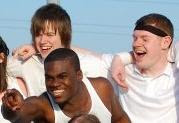After focusing on the visuals for so long, I decided it would be best to put that same focus into sound design.
Sound design is something I have lacked in the past and I think it is something that lacks in a lot of student films.
However, I would not consider myself a great musician but I would know what kind of style I would like for my film.
I plan to get a musician involved during the post production stage but before I do this, I need to research the different types of music and sound design I feel would be appropriate for my film style.
I am currently on my 4th draft of my script and the story has developed into more of a dark fairytale. First of all, I will look at film soundtracks of similar style and mood to my film.
In Princess Mononoke, there are these little characters/spirits in the forest called Kodamas. I would like to do a homage to these characters in my film by creating a similar sound to what these characters create. Maybe I will use a similar sound for my Spirit of the Forest.
I also like the soundtrack at around 1:09 on this clip. Would be very nice for the more mysterious scenes in my film.
After my research on suspense, I felt that it would be best to keep the music ambient during most parts of my film. However, I have come across ambient music. This style of music would blend in very well to the natural sound I wish to create and could make my sound design very subtle but effective.
Using ambient sounds to create a soundtrack would be a great technique to use in my film and I wish to create something similar.
Back to Hitchcock, in the final scene of The Birds, there is a deathly silence to the scene. Apparently Hitchcock created this sound of silence using an electronic hum. In the book ' Hitchcock Truffaut' Hitchcock mentions "To describe a sound accurately, one has to imagine its equivalent in dialogue". He describes his sound of silence "It was a strange, artificial sound, which in the language of the birds might be saying, "We're not ready to attack you yet, but we're getting reading. We're like an engine that's purring and we may start off at any moment" All of this was suggested by a sound that's so low that you can't be sure whether you're actually hering it or only imagining it."
I can't find a clip of the scene online but I will put one up as soon as I do.
